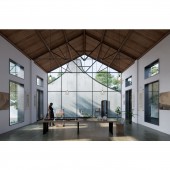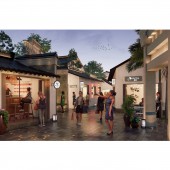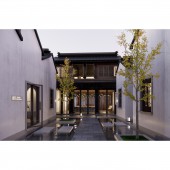DESIGN NAME:
Shantang Street Phase IV
PRIMARY FUNCTION:
Renewal Planning
INSPIRATION:
Shantang River and Shantang Street in Suzhou are important parts of the Grand Canal as a World Heritage Site. Shantang Street is a cultural street with a history of 1200 years, and was depicted in the painting, Prosperous Suzhou, created during the Qianlong Period of Qing Dynasty. The Li's Yizhuang parcel is located next to Zhenzhuo Bridge appeared in Prosperous Suzhou. It is the closest spot to Suzhou Tiger Hill Scenic Area.
UNIQUE PROPERTIES / PROJECT DESCRIPTION:
Shantang Street is a cultural street with a history of 1200 years. The new picture of the Shantang area will become a banner of community revival. The renewal of Shantang Street near Tiger Hill has been stagnant for ten years. There are piles of litter in the surroundings, and the buildings are left to decay. The launch of the Li's Yizhuang parcel renewal project is a catalyst for community revival, and rebuilding people's confidence in the community through implanting new commercial activities.
OPERATION / FLOW / INTERACTION:
Injecting new vitality into historic buildings and streets
According to the location and historical background of each parcel, we planned the corresponding commercial activities through on-site investigation. For example, Parcel A includes a group of Suzhou cultural relic buildings (Li's Yizhuang), 21 residential buildings and a warehouse of the Republic of China. The renewed parcel will be operated by Suzhou Xiaoyuan Hotel Management Company. The 21 residential buildings are renovated as hotel rooms; the west side of Li's Yizhuang and the warehouse of the Republic of China are renovated as the lobby and supporting facilities of the hotel. Li’s Yizhuang is renovated as a cultural exhibition space, so that the public can visit and experience the clan culture. Parcel B, Qu’s House, is composed of two buildings, one was built in Qing Dynasty and the other was built between the 1950s and 1980s. We took the Qu Jie boundary stone at the entrance as the main cultural value, and implanted exhibition, meeting, and communication spaces in Qu's House. Combining the unique spatial structure of historic buildings with contemporary cultural exhibitions and book displays can provide a very special experience, where ancient charm and new vitality coexist. Close to the Tao’s Ancestral Hall Parcel, the section from Dajingquan Lane to Fuquan Lane is the only section that has shops on both sides of the street in Shantang Phase IV. It also owns the most open waterfront view. Therefore, based on the intangible cultural heritage art of Kunqu Opera, this parcel is planned to become an integrated complex for cultural consumption including tea tasting, Kunqu opera performance, Kunqu opera experience, and selling derivatives and operating activities on intangible cultural heritage. In the Bao'en Temple Parcel, based on the long history of the temple and referring to the tradition of some foreign countries to have tourists staying in the temple overnight, we implanted a hotel format with temple characteristics for the parcel, stimulating the dynamic collision of traditional religious culture and modern lifestyle. These new programs will bring new life to this historic street and a steady stream of visitors.
Due to the lack of public space in the neighbourhood, we provide some spaces in the renewal design where people can stay and participate for free. We use the open space in front of each parcel as four landscape nodes, and create multiple dynamic gathering spaces based on the size of the land and the programs of the parcels . It can be a small garden along the river, where residents play chess under peach trees and enjoy the beauty of different seasons. It can also be a stone bench along the street, where visitors rest, order a cup of coffee, and appreciate the Shantang River and historic buildings. These places retain the nostalgic memories of the local residents, and provide visitors with the unique vitality of the historic street in the new era.
The Garden Lane and Maying Lane on Shantang Street were recorded in the map of Shantang Street in 1900 (the 26th year of Guangxu's Reign of the Qing Dynasty). These were where local residents used to sell the local specialty of three types of flowers (gardenia, magnolia, jasmine), which are historic alleys with traditional characteristics of Suzhou. Through planting the three types of flowers with modern landscape design, we integrate the cultural elements of three flowers into the historic alleys, so that the past scene of the alleys is reproduced when people resting under the flower trees. A dialogue between the new and the old is realized.
PROJECT DURATION AND LOCATION:
The project started in August 2021 in Suzhou, China, and still under construction now.
|
PRODUCTION / REALIZATION TECHNOLOGY:
Planning structure of four points and one line. The current situation of Shantang Street is overcrowded due to years of disorderly construction, which makes it difficult for people to experience the charm of historical streets. We have selected four important historical space node groups, Li's Yizhuang group, Qu Zhai group, Baoen Chan Temple group and Tao Zhenxiao Temple group. We hope to activate important clusters, become the catalyst of the block, and finally drive the gradual renewal of surrounding buildings.
The project involves planning and positioning, architectural design and landscape design. By studying the historical background of the building and carefully screening the existing buildings, we can make them present the original spatial structure. In combination with the spatial characteristics of each historical building, a new business form matching its space is implanted. At the same time, the street landscape of Shantang Street has also been redesigned in a unified way. By adding public space such as pocket square, the new vitality of the community will be refreshed, and people will have a complete historical experience when walking in the fourth phase of Shantang Street.
SPECIFICATIONS / TECHNICAL PROPERTIES:
Buildings' Renovation: Respecting Histoy, Restoring Historical Style
Inside each parcel, due to years of illegal constructions, the current site is overcrowded and messy. It's hard for people to experience the traditional charm of the historic streets and alleys. Through carefully screening, removing the illegal structures and preserving the historic buildings, we sort through the current space and make it reappear its original spatial organization. The unique neighborhood texture of street, alley, patio of Suzhou is revealed through the renovation. The passages between buildings which are too narrow are widened to ensure the evacuation and appropriate circulation. For the renovation of the interior of the buildings, we carefully inspected the internal structure of each building, and at the same time referred to the Yingzao Fayuan, which is a treatise on traditional architectural craftsmanship in Suzhou. So that the internal spatial structures and the characteristics of traditional houses in Suzhou are preserved and restored. Shantang Street is a national historic street of China. The planning requirement is to highly maintain the traditional style of the local buildings in Suzhou. Therefore, we are very cautious when designing the frontage of Shantang Street, continuing the traditional residence elements and retaining the mottled exterior walls. Even for the renewed windows and the roofs, they are also designed with traditional details of Suzhou.
TAGS:
Uraban Planning, Urban Design, Cultural Heritage, Community Renewal
RESEARCH ABSTRACT:
Social Significance
With the rapid development of modern transportation, many historic streets are gradually replaced by new towns. In China, some historic streets and neighborhoods are either facing the hollowing phenomenon and becoming dilapidated, or the historical and cultural features disappear due to excessive commercial development. These historic streets witness the development of local culture, and themselves are valuable historical carriers. However, due to the lack of proper maintenance and operation, their historical context cannot be read, and their historical value is not cherished. How to keep a good balance between "preservation" and "renew"? How to improve the living conditions of residents while respecting and protecting the history? How to bring the historic street with new vitality, and pass on its historical memory to people in a modern way? These are the questions faced by many conservators.
This project is an attempt to renew the historic street and is a banner of historic neighborhood revival. In the dialogues between the new and the old, the historic street provides public spaces for local residents to stay and talk, attracts tourists to read the local cultural background, and brings vitality and confidence to the community.
CHALLENGE:
Shantang River and Shantang Street in Suzhou are important parts of the Grand Canal as a World Heritage Site, located in a historically sensitive area. As early as the Qing Dynasty, Shantang Phase IV was depicted in the painting, Prosperous Suzhou, as a busy commercial street, with the beautiful and dynamic waterfront. However, today, the lively scene of Shantang Street no longer exists. There are few residents or tourists staying on the street. The neighbourhood lacks vitality.
The buildings along the street are generally in poor conditions and left to decay. Although some of them have a certain historical value, due to lack of maintenance, the buildings' structural safety level is low and can no longer be occupied. The internal alleys are overgrown with weeds. Due to years of illegal constructions, the current space is overcrowded and messy. It’s hard for people to experience the traditional charm of the historic streets and alleys.
The landscape along the Shantang River is quite rural, with weeping willows on the open water. However, part of the landscape along the river was ruined due to constructions, and other areas grow shrubs in poor shape. There is a lack of public open space for people to talk and rest along the street, and several spacious docks are also occupied by garbage. There are two alleys on Shantang Street, Garden Lane and Maying Lane, which were recorded in the map of Shantang Street in 1900 (the 26th year of Guangxu's Reign of the Qing Dynasty). They represent the historical memory of the residents on Shantang Street. But nowadays, they are also full of garbage, where tourists and residents cannot stay.
Young people have left the block to look for new opportunities, and the resident population is seriously aging. While protecting important historical space and continuing historical texture, introducing new business forms, activating historical space, providing open public space and rebuilding the confidence of community residents are the core objectives of this historical renewal plan.
ADDED DATE:
2023-02-28 11:28:06
TEAM MEMBERS (1) :
Yi Cheng, Yuhuan Zhang, Ziye Zhong, Zhiying Zhang
IMAGE CREDITS:
Yi Jian Architects, 2022.
|










